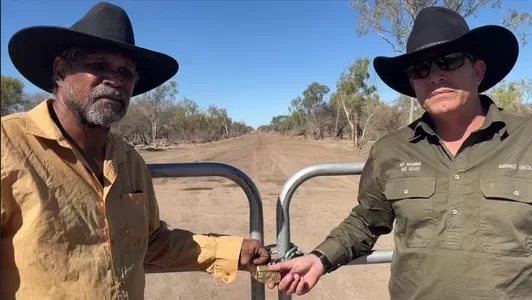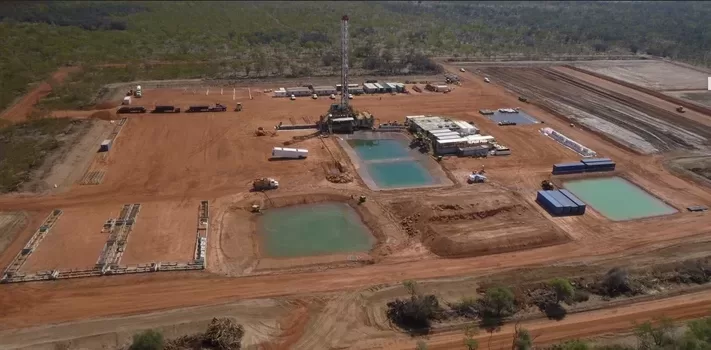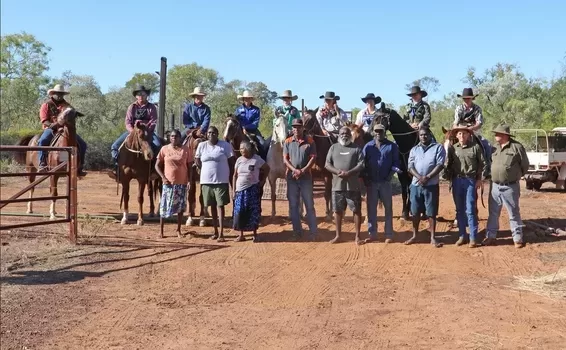Update: 24 August 2023 – Two workers allege they were told to keep spraying contaminated drill rig water around a gas fracking site in the Northern Territory’s Beetaloo Basin, despite the gas company knowing the fluid was contaminated.
An incident report provided to the NT government showed that in September last year, Tamboran Resources was worried it had too much water in a dam of drilling water at its Maverick 1 gas well on Tanumbirini Station.
The company ordered workers to lower the dam level. Tamboran said as soon as a senior manager realised the drill was being sprayed around that was immediately stopped and the government was informed.
The workers contested those claims, telling the ABC he was directed by Tamboran to keep spraying the contaminated water.
23 May 2023 – Less than three weeks ago, the Northern Territory government gave the go-ahead to controversial, full-scale fracking production in the Beetaloo Basin.
Last night, ABC’s 7:30 program reported Tamboran Resources, now the biggest fracking company in Beetaloo, has been involved with a number pollution incidents from one exploration drilling site, putting at risk people, stock, the environment and the sacred Newcastle Creek on Rallen’s Tanumbirini Cattle Station.
The three fracking pollution incidents on the Rallen cattle station are:
° drill water used to manage dust;
° a bund wall breaking spilling sediment and potentially toxic chemicals down towards a sacred waterway and
° what appears to be the pumping of toxic wastewater, containing heavy metals including lead, as well as barium, which is highly toxic to humans, stock, wildlife and the environment, into a cattle breeding paddock.
Rallen is one of Australia’s largest landowners, running six NT cattle stations and over 70,000 head of renowned Brahman cattle. Rallen Australia Director, Pierre Langenhoven said:
“We are shocked and worried that even at its first exploration well, Tamboran’s activities are putting staff, our cattle and Newcastle Creek, a sacred waterway for Traditional Owners, at significant risk from toxic pollution.
“What we’re seeing on the ground is that fracking and cattle operations can’t coexist. Keeping our pastures and water free of contamination, and staff safe, is critical but this is difficult when faced with this industrialised and dangerous industry.
“Neither Tamboran nor the NT government informed us about these incidents. We found out through our own investigations. We’ve had to push to get any kind of government response and when we requested test results we were told we couldn’t have them.”
Rallen Australia Director, Pierre Langenhoven said
The three incidents occurred between October 2022 and March 2023.
Incident 1: Toxic drill wastewater sprayed as ‘dust suppression’
On 1 October 2022 Tamboran directs an onsite company representative that toxic drill wastewater be used for “dust suppression” activities to reduce the sump freeboard level on the Maverick 1 well pad.
From 1 October, an estimated 314,600L of toxic mud sump wastewater was used for dust suppression and sprayed on the ground in Maverick 1 operations.
(As reported in Tamboran’s Quarter 4 (Dec) 2022 Quarterly Recordable Environmental Incident Report). The ABC reports Tamboran received a $6,500 penalty for the dust suppression incident.
Incident 2: Bund wall failure, chemical spill onto paddock
During the Territory wet in November 2022, a bund wall on the Tamboran Maverick 1 well pad failed after Incident 1 had occurred. The purpose of the bund wall around the pad is to confine all spills and storm water to the pad to avoid wash into the surrounding vegetation.
Tamboran’s EMP pad plans, which the Minister had approved, were marked “NOT FOR CONSTRUCTION”. Tamboran admitted that the sediment ponds/basins on the pad were not built to accommodate large rain events, “as the basin size to accommodate the volume of water collected from larger events would be impractical” and that assumptions were made about the expertise of the contract engineers in relation to the construction of an effective bund wall.
Pad sediment and potentially toxic chemicals were washed into the Tanumbirini paddock and down towards Newcastle Creek, a sacred waterway, areas of which are registered by the NT’s Aboriginal Areas Protection Authority. Reportable Incident Report here.
Incident 3: wastewater pumped in breach of plan
From at least 7 March 2023, Tamboran appears to have been pumping wastewater, which on 25 March contained heavy metals such as lead, and a drilling fluid additive barium which is highly toxic to animals and humans, from its unlined sediment dams into one of Rallen’s larger breeding paddocks on Tanumbirini Station, in breach of its own approved environment management plans and NT petroleum laws, regulations and guidelines.
The NT government is currently investigating Incident 3.
Associate Professor Ian A Wright from Western Sydney University undertook a pollution investigation for Rallen, testing wastewater at one of the pollution sites in relation to Incident 3.
His report concludes: “the wastewater disposed from the Sweetpea well site into Tanumbirini Station was polluted and is environmentally harmful” and “likely to contain contamination produced by the drilling operation at the site. … barium was the dominant metal recorded in the Sweetpea wastewater sample and is well-known as a lubricant used for drilling operations”.
The greatest concern is the concentration of barium in the wastewater which exceeds Australian drinking water guidelines.




Left: Johnny Wilson, Chair Nurrdalinji Aboriginal Corporation and Rallen Director Pierre Langenhoven
(Supplied: Nurrdalinji Aboriginal Corporation)
Right: Maverick 1 well drill pad Tanumbirini
Professor Wright notes in his preliminary investigation report:
“The elevated concentration of barium in Sweetpea wastewater samples poses several human health and environmental risks to people at the Sweetpea site and potentially to people exposed to well pad wastes at Tanumbirini Station. Exposure of people to barium has many potentially adverse health consequences, including cardiovascular disease, kidney disorders, metabolic, neurological and mental disorders (Kravchenko et al. 2014; Peanna et al. 2021). Barium also can also accumulate in the soil and can bioaccumulate in plants (Peanna et al. 2021)”.
Barium was also measured in the soil underneath the waste discharge hose at nearly four times the concentration found in the control location.
Levels of the other four metals identified – zinc, aluminium, lead and copper – exceeded the Australian guidelines for protection of aquatic species.
Associate Prof of Environmental Science, University of Western Sydney Dr Ian Wright, said:
“These incidents highlight the need for the Territory government to reform the environmental regulation of the onshore gas industry if they are ever going to rebuild public trust.
“This is pollution at the drilling stage only. The next stage, involving hydraulic fracking and large scale production, will potentially generate much larger volumes of contaminated water. With more drilling sites and contaminated water the environmental risks are looking enormous.
“The elevated concentration of barium in the wastewater samples collected poses significant risks to staff, cattle and the natural environment at the site. Exposure of people to barium has many potentially adverse health consequences, including cardiovascular disease, kidney disorders, metabolic, neurological and mental disorders. Barium can also accumulate in the soil and bioaccumulate in plants.”
Associate Prof of Environmental Science, University of Western Sydney Dr Ian Wright
NT government fails to enforce their own recommendations
“The NT government appears to be relying on the word of companies, without conducting its own checks and investigations or carefully checking companies‘ environmental management plans, and is not responding quickly and appropriately when serious incidents such as these take place.
“If this is exploration, we can only imagine what chaos the cattle industry will face if 6,000 of these fracking wells are drilled across the Beetaloo Basin.
Rallen Australia Director, Pierre Langenhoven said
Beetaloo Basin Traditional Owners
Djingili Elder and cultural advisor to Nurrdalinji, Janet Sandy Gregory speaks for the Beetaloo Basin Traditional Owners who are concerned fracking will damage country, water, sacred sites and songlines.
“This shows us once again why we do not want fracking which will poison our water, our animals and upset the songlines that run across our country.
“When I heard that Tamboran has polluted I felt my spirit and heart were breaking. I worry about the country and the future and what it’s going to hold for my family and my people.
“We want the government to take action against Tamboran. We have asked the Territory sacred sites authority to look into this because we fear for our country.”
Djingili Elder and cultural advisor to Nurrdalinji, Janet Sandy Gregory


Traditional Owners and Rallen station hands
Dr Sam Phelan, a vet and member of the Katherine group Protect Big Rivers said:
‘The Pepper Inquiry into Fracking was warned by experts of exactly these kinds of events happening, which is why it recommended that contaminated water should be housed in enclosed tanks.*
“This is just one of the recommendations that the NT government has decided to ignore, making a mockery of the scientific inquiry, the regulatory system and the idea that pastoral enterprises can coexist with fracking on their stations.
“Herd detention, when a cattle station can’t move or sell stock because of contamination, is a tragedy for any cattle enterprise, and that’s exactly what we will see if the industry and regulator continue to conduct themselves in this unprofessional way.”
Dr Sam Phelan, a vet and member of the Katherine group Protect Big Rivers
*See Rec 7.12, see page 20 of the NT government’s implementation plan: The government will not let gas companies release chemicals or wastewater into the environment. Gas companies will be required to have wastewater management and spill plans in place, will be prevented from discharging wastewater to drainage lines, waterways, temporary stream systems or waterholes, will have to enclose all wastewater in tanks to ensure waste does not leak out during the wet season, and design well pads to ensure that surface spills cannot leak down into underlying aquifers.
About Tamboran Resources
ASX-listed Tamboran is now the biggest player in the Beetaloo Basin. Its major investors include:
- Bryan Sheffield, Texan billionaire whose family is in the oil and gas industry
- Helmerich & Payne, the US’s biggest oil & gas drilling contractor
The company currently faces an ASIC and the ACCC complaint of “greenwashing”.
The NT Supreme Court is set to hear in November 2023 a review of a decision by NT Environment Minister to approve Tamboran’s plans to drill and frack 12 exploratory wells, with the Central Australian Frack Free Alliance (CAFFA) arguing the Minister failed to consider the broader climate impacts of full-scale gas production when approving the plan.
In April 2022 Tamboran was under threat of being referred for contempt of the Federal Senate for refusing to appear before an Inquiry into Fracking in the Beetaloo Basin.In June 2022 Tamboran locked the gate on the Chair of Nurrdalinji Aboriginal Corporation who was seeking to inspect the sacred site area of Newcastle Creek protected under the NT Sacred Sites Act.
Tamboran’s subsidiary Sweetpea is the first company to force access without the consent of pastoralists since the commencement in January 2021 of new NT Petroleum Regulations, designed to provide minimum protections to landowners in negotiating land access and compensation arrangements with petroleum companies.
Rallen Australia
Rallen is one of Australia’s largest landowners, running six NT cattle stations (Tanumbirini, Kalala, Big River, Larrizona, Mt McMinn and Forrest Hill) and over 70,000 head of cattle. Tanumbirini Station, the site of the incident, has one Tamboran and one Santos exploration well.
Tanumbirini is a 5,000 square km cattle station located near Daly Waters, 600km southeast of Darwin.
In January 2022 Rallen won a NT Supreme Court battle against Santos for its failure to inform Rallen of plans to drill additional wells on its Tanumbirini property.
During a recent Supreme Court action Rallen filed expert evidence demonstrating that the economic loss for the pastoral business from Sweetpea’s interference based on the activities it has proposed would be at least $1m/year and ongoing for the seismic activities alone, and if its 7 well program goes ahead, $3.5m over 5 years, assuming that Sweetpea will rehabilitate in the 5 years, which Rallen doubts is possible.
Rallen estimates it has spent $200 million in the NT since 2019 and employs many Territorians in establishing a renowned Brahman cattle business.
Related stories
Emissions wildly underestimated from fracking in NT
Meet the Frackers: Gas explorers in Australia
The Frackers: Senex, Gina Rinehart’s Hancock Energy & Posco
Environment law loophole allows new coal and gas
Gas exploration to resume offshore Sydney to Newcastle
Fugitive methane emissions cast dark cloud over Australia’s Net Zero ambitions
Carbon Credits Used to Plug Orphan Oil & Gas Wells to Halt Methane Emissions
Captured states relationship to fossil fuel industry
LNP = coal; ALP = gas Northern Territory is fracking the joint
Fracking for gas in the Northern Territory
The history of fracking – its a new technology George Mitchell





